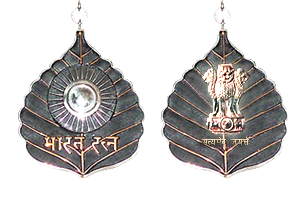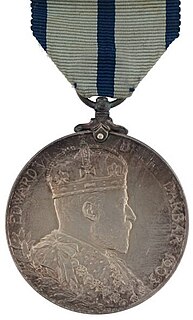 W
WThe Indian honours system is the system of awards given to individuals for a variety of services to the Republic of India. The categories of awards are as follows:
 W
WDelhi Durbar Medals were instituted by the United Kingdom to commemorate the Delhi Durbar where the new Emperor of India was proclaimed, in 1903 for Edward VII, and in 1911 for George V. On both occasions the medals were one and a half inches in diameter and were awarded in both gold and silver. They were worn in date order alongside Coronation and Jubilee medals on the left chest, suspended from a ribbon one and a quarter inches wide. These Royal commemorative medals were worn before campaign medals until November 1918, after which the order of wear was changed, with them now worn after campaign medals and before long service awards.
 W
WDelhi Durbar Medals were instituted by the United Kingdom to commemorate the Delhi Durbar where the new Emperor of India was proclaimed, in 1903 for Edward VII, and in 1911 for George V. On both occasions the medals were one and a half inches in diameter and were awarded in both gold and silver. They were worn in date order alongside Coronation and Jubilee medals on the left chest, suspended from a ribbon one and a quarter inches wide. These Royal commemorative medals were worn before campaign medals until November 1918, after which the order of wear was changed, with them now worn after campaign medals and before long service awards.
 W
WDewan Bahadur / Diwan Bahadur was a title of honour awarded during British rule in India. It was awarded to individuals who had performed faithful service or acts of public welfare to the nation. From 1911 the title was accompanied by a special Title Badge. Dewan literally means Prime Minister in Indian context and Bahadur means brave.
 W
WThe Indian Order of Merit (IOM) was a military and civilian decoration of British India. It was established in 1837, although following the Partition of India in 1947 it was decided to discontinue the award and in 1954 a separate Indian honours system was developed, to act retrospectively to 1947. For a long period of time the IOM was the highest decoration that a native member of the British Indian Army could receive and initially it had three divisions. This was changed in 1911 when Indian servicemen became eligible for the Victoria Cross. A civilian division of the IOM also existed between 1902 and 1939, however, it was only conferred very rarely.
 W
WNational Awards for e-Governance are presented every year by Department of Administrative Reforms & Public Grievances in India to recognize and promote excellence in implementation of e-Governance Initiatives.
 W
WThe Order of British India was an order of merit established in 1837 by the East India Company for "long, faithful and honourable service". The company's powers were removed after the Indian Mutiny, and the Order was incorporated into the British Honours System in 1859. The order became obsolete in 1947, after the partition of British India into the Dominion of India and the Dominion of Pakistan.
 W
WThe Imperial Order of the Crown of India was an order in the British honours system. The Order was established by Queen Victoria when she became Empress of India in 1878, and was named after the Imperial Crown of India. The Order was open only to women, and no appointments have been made since the Partition of India in 1947. The Order was limited to British princesses, wives or female relatives of Indian princes and the wife or female relatives of any person who held the office of:Viceroy of India, Governor of Madras, Governor of Bombay, Governor of Bengal, Commander-in-Chief India, Secretary of State for India, Governor-General of India.
 W
WThe Most Eminent Order of the Indian Empire was an order of chivalry founded by Queen Victoria on 1 January 1878. The Order includes members of three classes:Knight Grand Commander (GCIE) Knight Commander (KCIE) Companion (CIE)
 W
WPrime Minister's Awards for Excellence in Public Administration to acknowledge, recognize and reward the extraordinary and innovative work done by the Indian Civil Servants. Established in 2006 by the Government of India. It is awarded annually on Civil Services Day.
 W
WRai Sahib / Rao Saheb / Roy Sahib / Rao Sahib abbreviated R.S., was a title of honour issued during the era of British rule in India to individuals who performed faithful service or acts of public welfare to the nation. From 1911 the title was accompanied by a special Title Badge. Translated, Rai means "King" sahib means "leader".
 W
WTitle Badges were presented to Indian citizens who received certain formal titles of honour during British rule in India. They ceased to be awarded in 1947 on Indian independence.